duet
Schumann - Sonata in A minor - Alto Flute
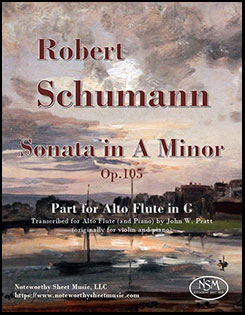 Sonata in A minor, Op.105, by Robert Schumann
Sonata in A minor, Op.105, by Robert Schumann
Transcribed for Alto Flute (and Piano) by John W. Pratt
Alto Flute Part, PDF $8.99
Sonata in A Minor, Opus 105, was the first of two violin sonatas composed by Robert Schumann in 1851. The first movement has a gentle melody very well suited to the alto flute and the kind of flowing piano accompaniment and overlapping harmonies one finds in much of Schumann's chamber music. The Allegretto, with its hesitations and shifting moods and motifs, is also well suited to the alto flute. The restless final movement is exciting and effective (and a workout for both players) whatever solo instrument is used. The range and dynamics of Schumann's violin part, as well as its character, fit the alto flute's nature and capabilities beautifully. We provide our alto flute transcription of the violin part; the piano score and original violin part are available elsewhere in the public domain as free pdf downloads (click on the link).
Alto Flute part, 9 pages of music; Total, 12 pages.
PreviewSchumann, Clara - Three Romances - Alto Flute or Flute (and Piano)
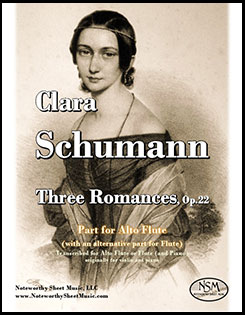 Three Romances, Op.22, by Clara Schumann
Three Romances, Op.22, by Clara Schumann
Transcribed for Alto Flute or Flute (and Piano) by C.A.Vater
Alto Flute Part and alternative Flute Part, PDF $8.99
Clara Schumann’s Drei Romanzen für Pianoforte und Violine, Op. 22, were written in 1853 and dedicated to the Schumanns’ great friend, the famous Hungarian violin virtuoso Joseph Joachim, with whom Clara performed the Three Romances when they concertized together on tours across Europe. The Romances are lovely, short pieces; melodic and expressive, they epitomize the Romantic era and represent true chamber music in the sense that both instruments are featured comparably, rather than the piano having a merely accompaniment role. They are nicely adaptable to wind instruments, and are particularly lovely when played on alto flute. Our transcription required few modifications to bring the original violin part completely in range for alto flute and provides flute-friendly, musically-appropriate alternatives to the occasional violin double-stop. Some flutists may wish to mix and match the three movements, preferring to play one or two of the Romances on alto flute and the third on concert flute, or vice versa; so, to that end, we have included in this edition a complete alternative part adapted for C-flute. We do not provide a re-notated copy of the score, however, since high-quality PDFs of the piano and violin score are freely available in the public domain, and are easy to use along with our flute transcriptions of the violin line. To download one such PDF of the score, please visit the imslp website.
Alto Flute part, 5 pages; Flute part, 5 pages; Total 14 pages.
PreviewSchumann, Clara – Sechs Lieder - trans. for Alto Flute (and piano)
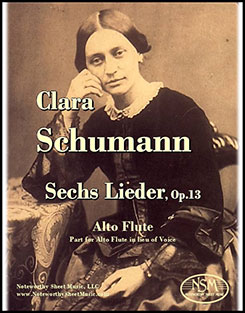 Sechs Lieder, by Clara Schumann
Sechs Lieder, by Clara Schumann
Transcribed for Alto Flute by C. A. Vater
Part for Alto Flute (in lieu of voice); PDF $5.99
In her Sechs Lieder, Op. 13, Clara Schumann set to music six German poems—two written by Heinrich Heine (Ich stand in dunklen Träumen and Sie liebten sich beide), three by Emanuel Geibel (Liebeszauber, Der Mond kommt still gegangen, and Die stille Lotosblume) and one by Friedrich Rückert (Ich hab’ in deinem Auge). Many of Clara Schumann’s songs were composed as gifts for her beloved husband Robert; they are romantic, melodic and highly expressive, and the Sechs Lieder of Op. 13 appropriately convey the broad array of intense emotions portrayed in the poetry that inspired them. These songs, which are absolutely charming, are nicely adaptable for a solo instrument in lieu of voice. They have been transcribed previously for violin or cello, and likely other instruments as well, but are particularly lovely when played on either alto flute or clarinet, instruments for which the voice line falls completely in range. Our Noteworthy Sheet Music editions of Op. 13 for alto flute or clarinet do not include re-notated versions of the score, since a high-quality PDF of the original piano and voice score is available free of charge in the public domain, and that piano accompaniment works perfectly well with our instrumental transcriptions of the voice line. The score we used when creating our parts may be downloaded from the IMSLP website. For NSM’s clarinet transcription of the Sechs Lieder voice line, please click the link.
Alto Flute Part, 4 pages; Total, 6 pages.
PreviewSchumann, Clara – Sechs Lieder - trans. for Clarinet (and piano)
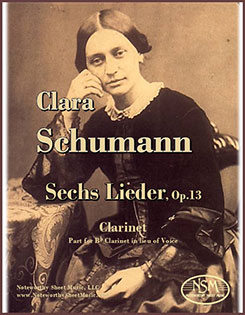 Sechs Lieder, by Clara Schumann
Sechs Lieder, by Clara Schumann
Transcribed for Clarinet by C. A. Vater
Part for B-flat Clarinet (in lieu of voice); PDF $5.99
In her Sechs Lieder, Op. 13, Clara Schumann set to music six German poems—two written by Heinrich Heine (Ich stand in dunklen Träumen and Sie liebten sich beide), three by Emanuel Geibel (Liebeszauber, Der Mond kommt still gegangen, and Die stille Lotosblume) and one by Friedrich Rückert (Ich hab’ in deinem Auge). Many of Clara Schumann’s songs were composed as gifts for her beloved husband Robert; they are romantic, melodic and highly expressive, and the Sechs Lieder of Op. 13 appropriately convey the broad array of intense emotions portrayed in the poetry that inspired them. These songs, which are absolutely charming, are nicely adaptable for a solo instrument in lieu of voice. They have been transcribed previously for violin or cello, and likely other instruments as well, but are particularly lovely when played on either alto flute or clarinet, instruments for which the voice line falls completely in range. Our Noteworthy Sheet Music editions of Op. 13 for alto flute or clarinet do not include re-notated versions of the score, since a high-quality PDF of the original piano and voice score is available free of charge in the public domain, and that piano accompaniment works perfectly well with our instrumental transcriptions of the voice line. The score we used when creating our parts may be downloaded from the IMSLP website. For NSM’s alto flute transcription of the Sechs Lieder voice line, please click the link.
B-flat Clarinet Part, 4 pages; Total, 6 pages.
PreviewScriabin - Romance - Transcribed for Clarinet, Flute, or Alto Flute
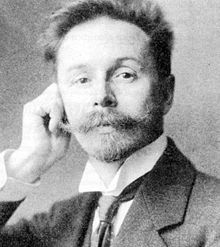 Romance, by Alexander Scriabin
Romance, by Alexander Scriabin
Transcribed for Clarinet or Flute or Alto Flute (and Piano) by J. W. Pratt
Parts, PDF $0.00
Alexander Scriabin (1872-1915), the mystic Russian composer with music to match, wrote nine mind-bending orchestral works and myriad mostly miniature piano pieces. He began as a "Russian Chopin" and ended planning a week-long "Mysterium" to be performed in the Himalayas using "an orchestra, a large mixed choir, an instrument with visual effects, dancers, a procession, incense, and ... mists and lights" (Wikipedia).
The Romance of 1890, his only chamber work except one variation for string quartet, is nearer the Chopin end of that spectrum, though the piano part adds harmonic and rhythmic complexities not evident from the solo part alone. —John W. Pratt, Jan. 19, 2016Please click on the links to download your free PDFs:
Transcription for clarinet required no changes of pitch. Scriabin - Romance - Clarinet
The transcription for flute is raised an octave, except the last five measures. Scriabin - Romance - Flute
The transcription for alto flute raises MM21-24 and MM36-48 an octave. Scriabin - Romance - Alto Flute
The piano score is freely available on IMSLP.org.
Scriabin image courtesy of Wikimedia.org, PD-old.
Slawinski - 5 Dessert Rounds - Two Flutes
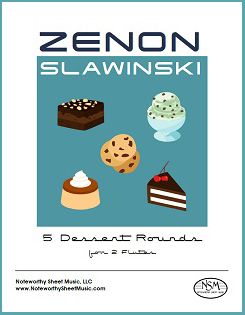 5 Dessert Rounds, by Zenon Slawinski
5 Dessert Rounds, by Zenon Slawinski
Contemporary Composition for Two Flutes
Score, PDF $4.99
Excerpts from the preface to the edition by Zenon Slawinski:
In most classic rounds the second voice begins and plays (or sings) the same melody as the first voice. That's the case here too for three of the five Dessert Rounds. Rounds 3 and 4 are different. In Round 3 - The Chocolate Chocolate Chip Cookie - the second voice plays the same melody but a third higher. In Round 4 - Sweet Potato Flan - the second voice plays the melody a 4th higher. // The Dessert Rounds are relatively simple and should not pose any difficulties for most intermediate players, although there are some tricky meter changes in Round 2 - Chocolate Mint Ice Dream - if you practice this slowly you'll soon be able to get past the meter changes and simply enjoy your dessert. // Round 4 - Sweet Potato Flan - is written in 7/4. // I purposely left off many performance markings so the players can make their own mark on the compositions. Interpret these pieces freely and have fun.
Zenon Slawinski, September 12, 2014
--------------------------------------------------------------------------------------------------------------
Click to listen to a few audio samples of the Dessert Rounds:
Score for two flutes, 6 pages; Total, 10 pages.
PreviewSlawinski - Bagette no. 4 - Flute & Piano
 Bagette no. 4, by Zenon Slawinski
Bagette no. 4, by Zenon Slawinski
Contemporary Composition for Flute and Piano
Flute Part and Piano Score, PDF $16.99
Zenon Slawinski studied music theory and composition at the University of Michigan with Leslie Bassett, William Bolcom, and William Albright. He also studied Campanology with Hudson Ladd. After graduating with honors he pursued a career in both music and graphic design. Mr. Slawinski was co-music director for the Peabody and Ohio State award winning Children's Radio Theatre program, and scored numerous independent and industrial films and films for the Smithsonian Institution that aired at Smithsonian museums and on PBS. He wrote the music to the popular political talk show The John McLaughlin Group. Mr. Slawinski was a founding partner of a multimedia production company and recording studio working in the early interactive days on educational and entertainment music projects in the CDi and CD-ROM formats, many of which won numerous awards. For more details of Zenon Slawinski's biography, please see the Composers section of the NSM website.
Bagette no. 4 is from a set of four Bagettes written by Zenon Slawinski for his flutist wife, for the two of them to play together. The piece showcases the flute and has challenging moments for both players throughout. The spelling of "bagette" is intentional. The piece opens and closes with a quick ostinato in ¾ in the piano part that lays the foundation for the feel of the entire Bagette. The second section is more pensive and contemplative, with the piano taking the lead initially. The next section is bold and in a new key - B major - and here the flute and piano engage in a playful interaction. The composer intends for the players to put their own spin on the piece and interpret the music freely.
You may also listen to audio of the piece, recorded on the composer's Yamaha MOTIF ES with the sampled piano and flute sounds found in the instrument. Click to listen
Customers who purchase the sheet music to Bagette no. 4 are entitled to a free rehearsal mp3 of the piano track with which the flutist can play along.
Piano score, 15 pages; Flute part, 7 pages; Total, 26 pages.
PreviewSlawinski - Cookies - Flute & Piano
 Cookies, by Zenon Slawinski
Cookies, by Zenon Slawinski
Contemporary Composition for Flute and Piano
Flute Part and Piano Score, PDF $24.50
From the preface by Zenon Slawinski:
The Cookies came about because my wife and I had been exploring the various compositions and arrangements available for flute and piano and I felt that we needed something new for our time and our audience. We live in a constantly changing world yet we love to hang our hat on the past, especially when it comes to music. I wanted to create a set of pieces that would not only be enjoyable for the listener but provide the players with a high level of satisfaction.
These pieces range in difficulty from the rather simple and easy to play (Cookies 1, 2, 4, 7), to the intermediate (Cookies 5, 8, 9, 11), and to the more challenging (Cookies 3, 6, 10, 12).
A special note about Cookie No. 5. This piece was influenced by the Jazz tunes in the popular series of Real Books which follow a common practice in today's "chart" or "lead sheets" where the melody line is written out and chords are marked for the accompaniment to play. This gives a lot of freedom initially to the piano. As the flutists becomes more familiar with their part, I would encourage them to get off the page and try some of their own lines.
I purposely gave few performance markings so that players can create their own. Interpret these freely and have fun.
Zenon Slawinski, September 17, 2014
You may listen to some short audio samples of the Cookies, recorded on the composer’s Yamaha MOTIF ES with the sampled piano and flute sounds found in the instrument.Cookie 2 mp3
Cookie 3 mp3
Cookie 9 mp3 Cookie 10 mp3
Customers who purchase the sheet music to Cookies are entitled to free rehearsal mp3’s of the piano tracks with which the flutist may play along.
Cookie 9 is a flute solo; the piano is tacet.
Cookies 1 to 12, complete edition: Piano score, 60 pages; Flute part, 21 pages; Total, 84 pages, PDF Price $24.50.Preview
For those who would prefer to buy a subset of the Cookies, rather than all 12, we offer three smaller editions:
Cookies 1,2,4,7: Piano Score, 15 pages; Flute part, 5 pages; Total 24 pages; PDF Price $9.45
Cookies 5,8,9,11: Piano Score, 15 pages; Flute part, 7 pages; Total 28 pages; PDF Price $9.45
Cookies 3,6,10,12: Piano Score, 30 pages; Flute part, 9 pages; Total 42 pages; PDF Price $18.90
Tchaikovsky - Arab Dance - Alto Flute & Harp/Piano
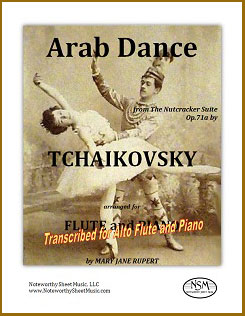 Arab Dance, by P. Tchaikovsky
Arab Dance, by P. Tchaikovsky
Arranged for Flute and Harp or Piano by Mary Jane Rupert
Transcribed for Alto Flute by C.A.Vater
Alto Flute Part and Harp or Piano Score, PDF $7.99
Mary Jane Rupert's arrangement of The Nutcracker for flute and harp or piano includes all of the pieces from the original Suite, Op. 71a, except the Overture. Dr. Rupert stayed as close as possible to the original orchestration, in terms of key, harmony, register, and color. Originally published in 1988, the arrangement was re-edited by Dr. Rupert in 2013 for publication as separate flute/piano and flute/harp editions by Noteworthy Sheet Music. After creating the new flute editions, Noteworthy Sheet Music's editors realized that one of the pieces of the suite in particular, Arab Dance, would work beautifully on alto flute. We created an alto flute transcription of the flute part, both for ourselves and for our alto flutist friends.
We offer separate versions of the score for piano or harp, although in the case of the Arab Dance the harp-specific notation is minimal compared to some of the other pieces contained in the complete edition of The Nutcracker arranged for flute and harp.
 Alto Flute & Harp Edition: Harp score, 6 pages; Alto Flute part, 1 page; Total, 10 pages. $7.99
Alto Flute & Harp Edition: Harp score, 6 pages; Alto Flute part, 1 page; Total, 10 pages. $7.99Preview
 Alto Flute & Piano Edition: Piano score, 6 pages; Alto Flute part, 1 page; Total, 10 pages. $7.99
Alto Flute & Piano Edition: Piano score, 6 pages; Alto Flute part, 1 page; Total, 10 pages. $7.99
Preview
Tchaikovsky - The Nutcracker - Flute & Harp
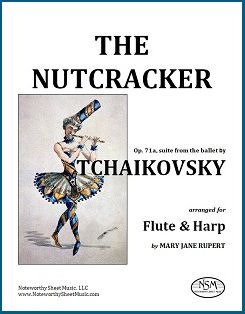 The Nutcracker, by P. Tchaikovsky
The Nutcracker, by P. Tchaikovsky
Arranged for Flute and Harp by Mary Jane Rupert
Flute Part and Harp Score, PDF $17.95 (also available as individual pieces)
Mary Jane Rupert, pianist and harpist, has performed as soloist, chamber musician, and orchestral player in many groups in the Boston area throughout the past three decades. She has toured the United States, Thailand, and New Zealand as a member of the duo "2" with flutist Peter Bloom, and performed with such other groups as the Southcoast Chamber Players, Musica Sacra, the Cecilia Society, and the Boston Philharmonic Orchestra. Educated at Oberlin College and Indiana University, Ms. Rupert earned a B.M. in piano, M.M. degrees in both harp and piano, and a doctorate in piano performance. Having taught at Western Michigan University, Oberlin College, and Wellesley College, she now maintains a private studio for both piano and harp in Cambridge, MA.
Dr. Rupert's superb arrangement of The Nutcracker for flute and harp includes all of the pieces from the original Suite Op.71a from the ballet by Tchaikovsky, except the Overture. Originally published in 1988 by New Boston Editions, the arrangement has been re-edited by Dr. Rupert and re-notated by NSM for this new edition, which is available as a PDF download. Professionals, students, and amateur musicians should all find uses for these popular pieces—as encores, recital pieces, and as part of the repertoire for more informal musical occasions.
Cynthia Price-Glynn, Principal Harp of the Boston Ballet and Chair of the Harp Department at the Boston Conservatory writes: "Mary Jane Rupert has done a masterful job of capturing the mood, attitude, and even humor of these pieces that are recognizable all year round. Her partnering of the two instruments actually mirrors the color and nuances of the original orchestration." Read the full review here.
Jan Jennings writes in The Harp Column: "Dr. Rupert uses enharmonics to play repeated notes cleanly and adds some p.d.l.t. sections for variety in "March." "Dance of the Sugar Plum Fairy" is a charming arrangement with the harp harmonizing with the flute in sixths. The harp is featured in measures 32-36 and brings to mind the original orchestration. "Trepak (Russian Dance)," "Arab Dance" and "Chinese Dance" are all pretty readily playable. "Dance of the Reed Flutes" is more challenging and the harp harmonizes with the flute in thirds. The signature piece of the suite is, of course, "Waltz of the Flowers" and includes the cadenza." Read the full review on The Harp Column website.
Complete Edition: Harp score, 44 pages; Flute part, 14 pages; Total, 64 pages. $17.95Preview
For anyone wishing to purchase individual pieces of Mary Jane Rupert's arrangement of The Nutcracker for flute and harp, rather than the entire suite, we also offer the seven pieces as separate PDF's. Just check the appropriate box in the Add to Cart table below:
==========================================================
We also offer a professionally-printed hard copy of the complete edition of The Nutcracker by Tchaikovsky, arranged for Flute and Harp for $33.33 plus a $5.95 shipping and handling fee to addresses in the USA. Use the Contact Us form to let us know which hard copy publication(s) you would like to purchase, along with your email contact information and USPS mailing address. We will then send you a PayPal invoice for the sale and, once we receive notice from PayPal that you have paid for the item(s), we will ship your music to the address provided.
